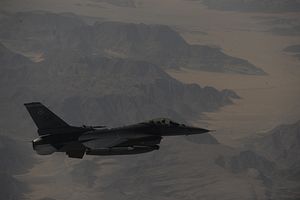Last week, IHS Jane’s Defense Weekly reported that Pakistan is seeking to purchase an additional 10 Lockheed Martin F-16 Block 52 fighters. These fighters would be in addition to the eight U.S. F-16s that were recently authorized by the U.S. State Department in February. A senior Pakistani government official told IHS Jane’s that a “decision in principle has been made to buy 10 more F-16s.”
Pakistan’s air force is looking to retire 190 planes from its current fleet, according to Dawn. A senior defense official who spoke to the Pakistani daily said that while plans to order additional F-16s weren’t finalized, Pakistan does “need to retire 190 planes by 2020.” “And we already looking for various options,” the official added.
February’s F-16 deal was estimated to stand at $699 million, according to the U.S. Defense Security Cooperation Agency. The F-16 sale ultimately survived a difficult vote in the U.S. Senate, where Senate Foreign Relations Chairman Bob Corker raised concerns about continuing U.S. military support for Pakistan given Islamabad’s torpor on combating terror groups, including the Haqqani network. Senator Rand Paul, meanwhile, cited Paksitan’s human rights record and support for the Afghan Taliban as reasons to oppose the sale. Ultimately, the Senate cleared the deal 71-24, suggesting that another F-16 sale would likely also make it through the body.
The Pakistan Air Force currently operates a fighter force comprising F-16s, Dassault Mirage IIIs and 5s, Chengdu F-7s, and JF-17s, the latter a low-cost joint venture between Pakistan and China. F-16s, with their tactical nuclear delivery capabilities, play a particularly important role for Pakistan in bolstering its conventional abilities against its neighbor and rival, India.
Beyond Pakistan’s tactical requirements, the U.S. sale of F-16s, including the recent deal for eight units, has geopolitical implications. As Rohan Joshi recently explained in The Diplomat, “the prospective sale of eight F-16s to Pakistan follows a well-established pattern of the U.S. attempting to induce Pakistani action through incentivization.” The incentivization in question currently relates to Pakistan’s central role in helping bring the Afghan Taliban to the negotiating table with the Afghan government; Pakistan’s government is known to exercise some leverage over the Afghan leadership.
However, amid recent reports that Pakistan’s leverage over the Taliban might be diminished following last year’s revelations that the group’s longstanding leader, Mullah Mohammed Omar, had been dead since 2013, much remains uncertain about what Islamabad can promise to deliver in these talks.
Making matters more interesting, last fall, reports in the Russian press, eventually confirmed by Pakistani officials, suggested that Pakistan was looking toward Russia as a potential alternate source of new fighters. In particular, Pakistan may be interested in purchasing Russia’s Su-35 Flanker E fighter, which, though possessing a different feature set from the F-16, would likely be a useful asset for Pakistan’s air force. Though analysts met initial reports that Pakistan would consider the Su-35 option seriously with skepticism, this is largely uncharted territory. Russia only lifted a longstanding arms embargo against Pakistan in 2014.
The Russian option could offer Pakistan additional financial flexibility, as Moscow is often willing to work with its arms customer on favorable long-term financing arrangements and sweeten its deals with servicing support. (Pakistan doesn’t operate any current generation Russian jets so this would be a concern; F-16s would be considerably simpler to incorporate.) Ultimately, F-16 or Su-35, the matter of Pakistan adding additional fighters to its current fleet might come down to mundane matters of what is financially feasible.

































